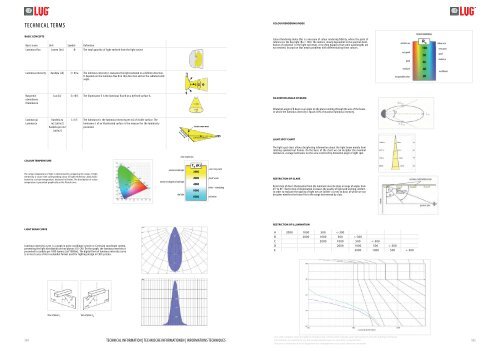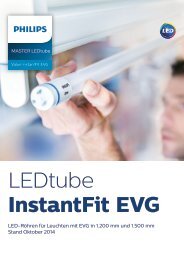- Page 1 and 2:
YOUR WORLD, OUR LIGHT
- Page 3 and 4:
LUG - EXPERT IN LIGHTING LUG - WORL
- Page 6:
APPLICATIONS LUG LUG For over 25 ye
- Page 9:
CUSTOMIZATION OF SOLUTIONS One of t
- Page 12 and 13:
Modern trends The range of lighting
- Page 14 and 15:
DECORATIVE LUMINAIRES AND LIGHTING
- Page 16 and 17:
PLAFONDS | DECKEN- UND WANDLEUCHTEN
- Page 18 and 19:
1 ARGUS ONE LED EN DE FR modern pen
- Page 20 and 21:
1 ARGUS ONE IP44 EN DE FR pendant d
- Page 22 and 23:
1 ARGUS ONE SWITCH ARGUS ONE AW LED
- Page 24 and 25:
1 ARGUS ONE n/t IP20 EN DE FR moder
- Page 26 and 27:
1 ARGUS ONE System n/t EN DE FR sys
- Page 28 and 29:
1 ARGUS ONE g/k EN DE FR decorative
- Page 30 and 31:
1 ARGUS trimless EN DE FR frameless
- Page 32 and 33:
1 ARGUS ONE System g/k accessories
- Page 34 and 35:
1 ARGUS TWO n/t EN DE FR decorative
- Page 36 and 37:
1 ARGUS WALL 1 IP44 EN DE FR decora
- Page 38 and 39:
1 VIGO System g/k LED EN DE FR mode
- Page 40 and 41:
1 VOLICA LED EN DE FR suspended dec
- Page 42 and 43:
1 VOLICA EN DE FR pendant decorativ
- Page 44 and 45:
1 VOLICA SYSTEM EN DE FR System of
- Page 46 and 47:
1 VERTICA LED EN DE FR modern floor
- Page 48 and 49:
1 A-LINE MOVE EN DE FR pendant deco
- Page 50 and 51:
1 A-LINE System accessories | A-LIN
- Page 52 and 53:
1 CIRRUS CIRRUS n/t EN DE FR direct
- Page 54 and 55:
1 CIRRUS 2 EN DE FR decorative pend
- Page 56 and 57:
1 CIRRUS 2 n/t EN DE FR decorative
- Page 58 and 59:
1 CIRRUS 2 DIRECT EN DE FR direct l
- Page 60 and 61:
1 ARKADIA MIX 150062.00060 150062.0
- Page 62 and 63:
1 FOCUS FOCUS FOCUS n/t FOCUS FOCUS
- Page 64 and 65:
1 PORTO EN DE FR decorative luminai
- Page 66 and 67:
1 RUBIA 1 L W H 010212.1201.241 2×
- Page 68 and 69:
1 The LUG Company reserves right to
- Page 70 and 71:
1 U-SYSTEM Halogen EN DE FR recesse
- Page 72 and 73:
1 U-SYSTEM MIX Halogen EN DE FR rec
- Page 74 and 75:
1 SYSTEM PLUS MH EN DE FR decorativ
- Page 76 and 77:
1 SYSTEM PLUS accessories | SYSTEM
- Page 78 and 79:
IK IK 03 06 TINO LED 2 EN DE FR mod
- Page 80 and 81:
IK 09 DRACO LED 2 EN DE FR modern s
- Page 82 and 83:
2 The LUG Company reserves right to
- Page 84 and 85:
NUOVO LED 2 CASE STUDY ASSUMPTIONS
- Page 86 and 87:
2 The LUG Company reserves right to
- Page 88 and 89:
ATLAS MINI LED 2 EN DE FR modern in
- Page 90 and 91:
2 The LUG Company reserves right to
- Page 92 and 93:
PROXIMA CASE STUDY 2 ASSUMPTIONS 3
- Page 94 and 95:
2 The LUG Company reserves right to
- Page 96 and 97:
IK 05 ROBIN MINI PLUS 2 EN DE FR in
- Page 98 and 99:
SKYLER LED 3-PHASE ALUMINIUM TRACK
- Page 100 and 101:
2 The LUG Company reserves right to
- Page 102 and 103:
IK 02 IK 04 LUGSTAR SHOP LED 3 EN D
- Page 104 and 105:
LUGSTAR PREMIUM LED CASE STUDY ASSU
- Page 106 and 107:
3 The LUG Company reserves right to
- Page 108 and 109:
LUGSTAR DYSTANS PREMIUM LED 3 EN DE
- Page 110 and 111:
IK 06 LUGSTAR HORIZONTAL LED 3 EN D
- Page 112 and 113:
IK 06 JESSE LED JESSE 1 LED 3 1) 1)
- Page 114 and 115:
DIAMOND Halogen p/t 3 EN DE FR rece
- Page 116 and 117:
LUGSTAR p/t LUGSTAR faceted p/t 3 E
- Page 118 and 119:
LUGSTAR ECO p/t LUGSTAR ECO faceted
- Page 120 and 121:
LUGSTAR BASIC p/t LUGSTAR BASIC p/t
- Page 122 and 123:
CROSSO p/t CROSSO p/t 3 - L H L W 0
- Page 124 and 125:
LUGSTAR HORIZONTAL n/t LUGSTAR HORI
- Page 126 and 127:
3 The LUG Company reserves right to
- Page 128 and 129:
IK 04 SPARK LED 3 EN DE FR recessed
- Page 130 and 131:
LUGSTAR MH p/t 3 EN DE FR recessed
- Page 132 and 133:
LUGFIRE MH p/t CROSSO Glass MH 3 EN
- Page 134 and 135:
GLASS & PLASTER LUMINAIRES GLAS- UN
- Page 136 and 137:
G24q G24q ADOBA ARESA EN DE FR glas
- Page 138 and 139:
EKO Q G24q EKO V 4 EN DE FR plaster
- Page 140 and 141:
TRIADA MAX G24q G24q TRIADA EN DE F
- Page 142 and 143:
INDIRECT LIGHT LUMINAIRES INDIREKTE
- Page 144 and 145:
IK 05 SOFT BASIC EN DE FR recessed
- Page 146 and 147:
SOFT DUO-PAR SOFT PAR W L H EN DE F
- Page 148 and 149:
LOUVER & RECESSED LUMINAIRES RASTER
- Page 150 and 151:
IK 07 LUGCLASSIC LED p/t EN DE FR m
- Page 152 and 153:
6 The LUG Company reserves right to
- Page 154 and 155:
IK 07 LUGCLASSIC ECO LED TUNABLE WH
- Page 156 and 157:
LUGCLASSIC T5 g/k 625x625 PAR W EN
- Page 158 and 159:
LUGCLASSIC DECOR T5 600x600 p/t PAR
- Page 160 and 161:
LUGCLASSIC T8 p/t PAR LUGCLASSIC T8
- Page 162 and 163:
40 LUGCLASSIC T8 g/k LUGCLASSIC T8
- Page 164 and 165:
LUGCLASSIC AS n/t LUGCLASSIC AS 600
- Page 166 and 167:
LUGCLASSIC SPOT g/k LUGCLASSIC QUAD
- Page 168 and 169:
LUGCLASSIC FLOW T5 p/t PAR LUGCLASS
- Page 170 and 171:
CLEAN ROOM LIGHTING BELEUCHTUNG DER
- Page 172 and 173:
MEDICA 2 p/t MEDICA 2 600x600 p/t L
- Page 174 and 175:
IK 06 MEDICA 2 g/k EN DE FR modern
- Page 176 and 177:
IK 06 MEDICA 2 HERMETIC p/t QND CON
- Page 178 and 179:
CODE STRUCTURE | AUFBAU BESTELLUNGS
- Page 180 and 181:
IK 06 IK 06 MEDICA 1 g/k MEDICA 1 n
- Page 182 and 183:
LUGTRACK LED EN DE FR modern LED lu
- Page 184 and 185:
8 The LUG Company reserves right to
- Page 186 and 187:
LUGTRACK 5 accessories Accessories
- Page 188 and 189:
PROLINE EN DE FR quick-assembly lig
- Page 190 and 191:
LUGTRACK 10 g/k EN DE FR quick-asse
- Page 192 and 193:
LUGLINE OVERLAPP LUGLINE CONNECT EN
- Page 194 and 195:
INDUSTRIAL LUMINAIRES | INDUSTRIELE
- Page 196 and 197:
LUGHALLE 1 IP20 / IP54 LUGHALLE 2 I
- Page 198 and 199:
IK 07 IK 10 LUGHALLE IP65 NEW NEW C
- Page 200 and 201:
LUGSFERA IP20 / IP65 LUGSFERA IP20
- Page 202 and 203:
LUGSFERA accessories | LUGSFERA Zub
- Page 204 and 205:
IK 07 PETROL ROUND p/t PETROL 2 n/t
- Page 206 and 207:
IK 05 ATLANTYK STRONG LED EN DE FR
- Page 208 and 209:
9 The LUG Company reserves right to
- Page 210 and 211:
IK 09 T10 ATLANTYK STRONG T5 ATLANT
- Page 212 and 213:
VANDALLUG VANDALLUG T5 L W H D1 D2
- Page 214 and 215:
IK 06 IK 06 RAYLUX OPAL RAYLUX PRYZ
- Page 216 and 217:
PLAFONDS DECKEN- UND WANDLEUCHTEN P
- Page 218 and 219:
IK 08 40 AMBRA LED motion EN DE FR
- Page 220 and 221:
IK 10 CALLA LED MOTION EN DE FR mod
- Page 222 and 223:
ARUBA D W H EN DE FR glass plafond
- Page 224 and 225:
IK 07 IK 07 CUBE CUBE motion L L L
- Page 226 and 227:
RICOSTA / ARCOLA / ENIGMA RICOSTA A
- Page 228 and 229:
JUPITER / MULTIJUPITER JUPITER WENU
- Page 230 and 231:
OMEGA / MULTIOMEGA OMEGA SIGMA / MU
- Page 232 and 233:
NERO 1 / MULTINERO 1 NERO 1 NERO 2
- Page 234 and 235:
FLOODLIGHTS FLUTLICHTLEUCHTEN PROJE
- Page 236 and 237:
POWERLUG 2 EN DE FR wide-beam flood
- Page 238 and 239:
IK 08 POWERLUG 1000 SM POWERLUG 100
- Page 240 and 241:
IK 08 POWERLUG PREMIUM POWERLUG PRE
- Page 242 and 243:
IK 08 POWERLUG PREMIUM 2000W AS POW
- Page 244 and 245: IK 08 HEVELIUS PREMIUM 2000W CIRCUL
- Page 246 and 247: POWERLUG PREMIUM WAY POWERLUG PREMI
- Page 248 and 249: IK 08 URBANO LED EN DE FR professio
- Page 250 and 251: CITY LED B D EN DE FR professional
- Page 252 and 253: IK 05 LUGTRAIN LED EN DE FR suspend
- Page 254 and 255: IK 10 65/20 LUGTRAIN EN DE FR suspe
- Page 256 and 257: LUGSAN 4 PREMIUM CONVEX LUGSAN 4 PR
- Page 258 and 259: IK 08 QUART LED EN DE FR decorative
- Page 260 and 261: ARAMIS W L ARAMIS CUBE H H L H EN D
- Page 262 and 263: UMBRELLA MAX L 392 W UMBRELLA MAX W
- Page 264 and 265: MODENA LED EN DE FR decorative wall
- Page 266 and 267: DMX System LED Lighting Control Sys
- Page 268 and 269: ROTUNDA 1 LED EN DE FR decorative f
- Page 270 and 271: ROTUNDA 1 ROTUNDA 2 EN DE FR decora
- Page 272 and 273: CARO 1 LED EN DE FR decorative faca
- Page 274 and 275: CARO 1 CARO 2 EN DE FR decorative w
- Page 276 and 277: CARO MINI 1 CARO MINI 2 EN DE FR sm
- Page 278 and 279: ICE CUBE 2 LED EN DE FR small decor
- Page 280 and 281: IK 10 INTEGRA LED EN DE FR wall rec
- Page 282 and 283: AVALON p/t GROUNDLUG REGULATE EN DE
- Page 284 and 285: IK 10 GROUNDLINE MAT LED EN DE FR d
- Page 286 and 287: IK 10 IK 10 RUNA 3 LED RUNA 4 LED E
- Page 288 and 289: IK 09 KATLA LED SANTORYN LED EN DE
- Page 290 and 291: IK 10 ARARAT LED EN DE FR modern sp
- Page 292 and 293: ICONS DESCRIPTION ICONS DESCRIPTION




